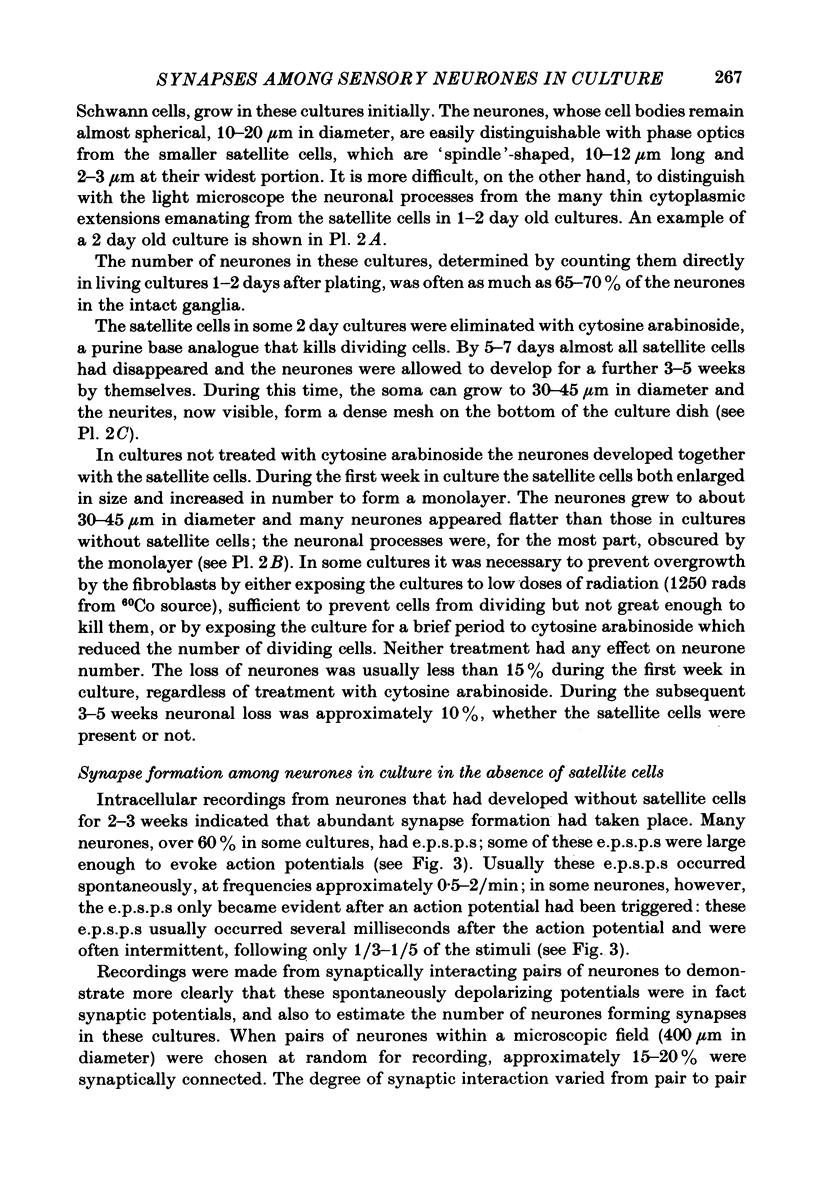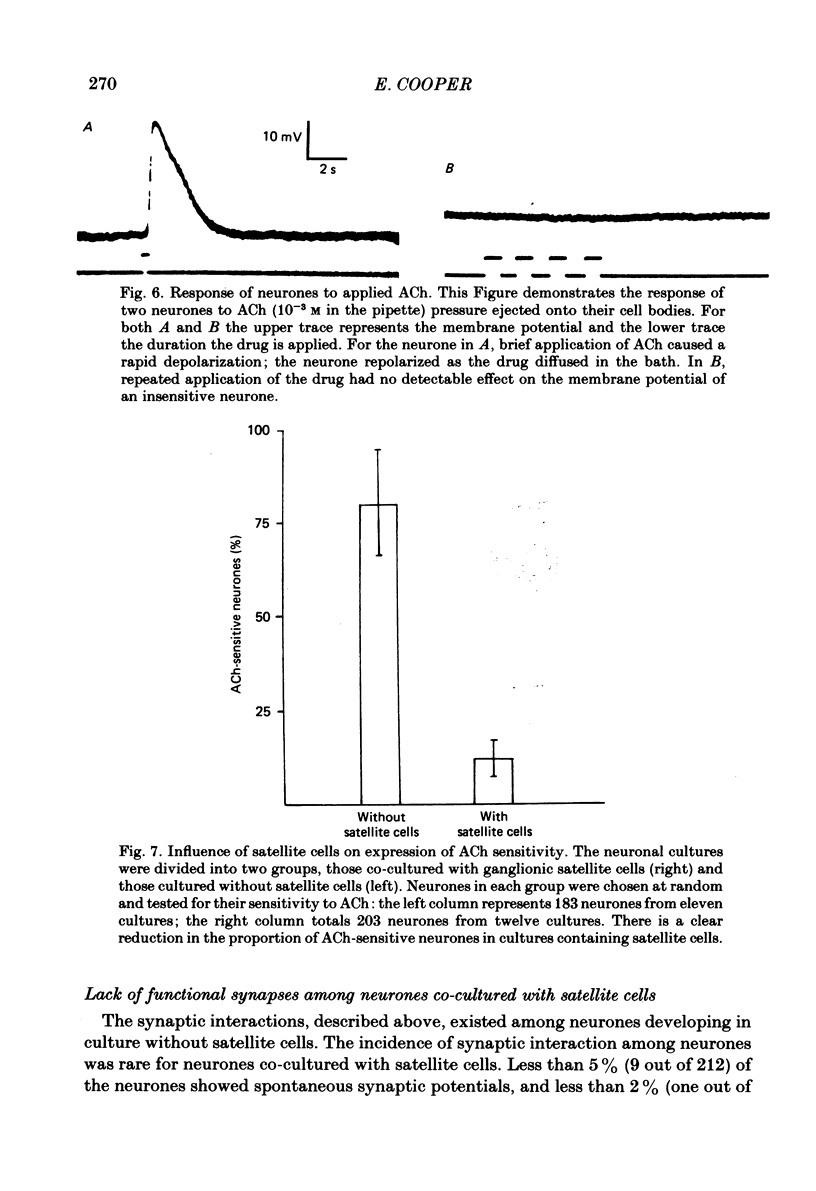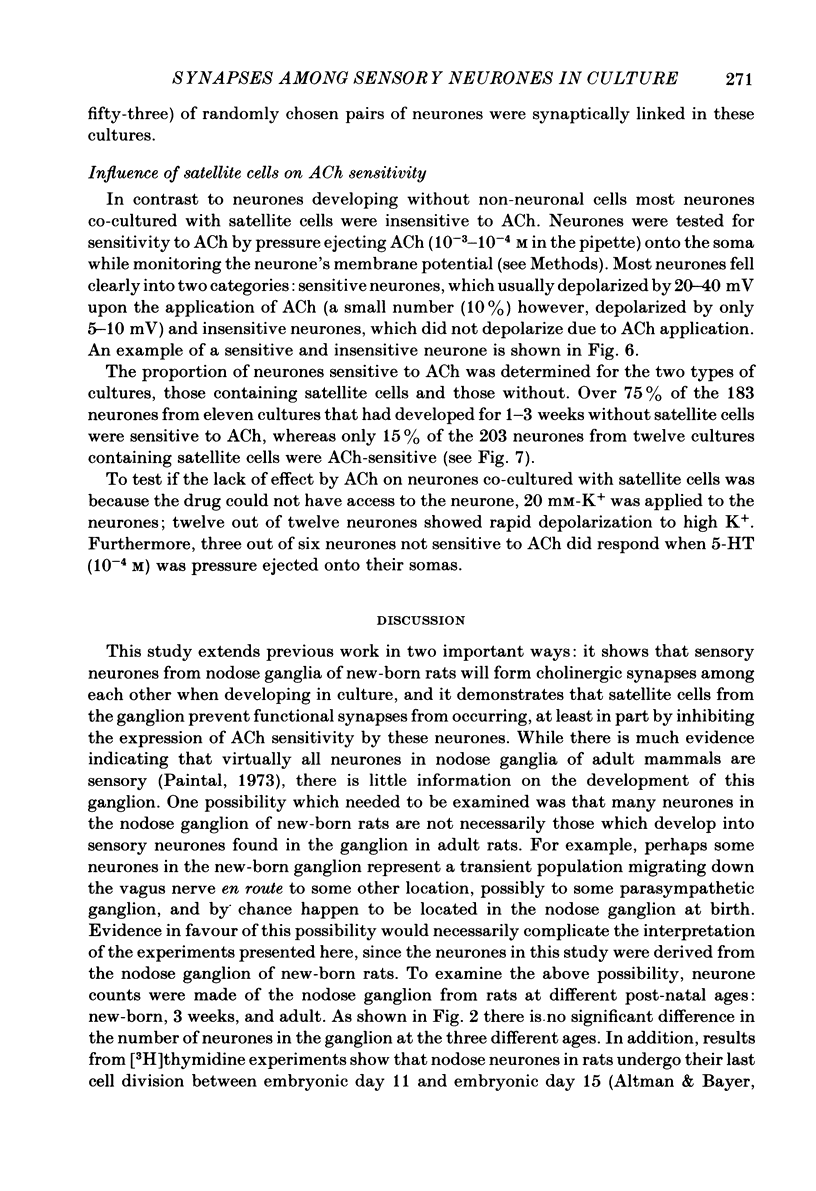Abstract
Sensory neurones from new-born rat nodose ganglia were grown in tissue culture, either with or without the ganglionic satellite cells, in order to investigate influences of satellite cells on sensory neurone development. To learn more about the post-natal development of nodose ganglia in rats neuronal counts of the ganglion were made at three different developmental stages. There were no significant differences of neuronal number in nodose ganglia in new-born rats, rats 3 weeks of age, and adult rats. Up to 60% of the neurones formed synapses with each other when they developed in culture without ganglion satellite cells. Pharmacological experiments indicated that the transmitter at these synapses was ACh and the post-synaptic receptors were nicotinic. Neurones co-cultured with satellite cells rarely formed functional synapses and most (85%) were not sensitive to ACh: 75% of neurones cultured without satellite cells were ACh sensitive. These results provide evidence that mammalian sensory neurones form synapses among each other in culture. The results also suggest that ganglionic satellite cells prevent functional synapses among these neurones from occurring, in part because the neurones do not express ACh sensitivity when co-cultured with satellite cells.
Full text
PDF













Images in this article
Selected References
These references are in PubMed. This may not be the complete list of references from this article.
- Ayer-Le Lievre C. S., Le Douarin N. M. The early development of cranial sensory ganglia and the potentialities of their component cells studied in quail-chick chimeras. Dev Biol. 1982 Dec;94(2):291–310. doi: 10.1016/0012-1606(82)90349-9. [DOI] [PubMed] [Google Scholar]
- Baccaglini P. I., Cooper E. Electrophysiological studies of new-born rat nodose neurones in cell culture. J Physiol. 1982 Mar;324:429–439. doi: 10.1113/jphysiol.1982.sp014122. [DOI] [PMC free article] [PubMed] [Google Scholar]
- Baccaglini P. I., Cooper E. Influences on the expression of acetylcholine receptors on rat nodose neurones in cell culture. J Physiol. 1982 Mar;324:441–451. doi: 10.1113/jphysiol.1982.sp014123. [DOI] [PMC free article] [PubMed] [Google Scholar]
- Falempin M., Rousseau J. P. Reinnervation of skeletal muscles by vagal sensory fibres in the sheep, cat and rabbit. J Physiol. 1983 Feb;335:467–479. doi: 10.1113/jphysiol.1983.sp014544. [DOI] [PMC free article] [PubMed] [Google Scholar]
- Fujiwara M., Kurahashi K., Mizuno N., Nakamura Y. Involvement of nicotinic and muscarinic receptors in synaptic transmission in cat superior cervical ganglions reinnervated by vagal primary afferent axons. J Pharmacol Exp Ther. 1978 Apr;205(1):77–90. [PubMed] [Google Scholar]
- Gaudin-Chazal G., Portalier P., Puizillout J. J., Vigier D. Simultaneous visualization of aortic and [3H]5-hydroxytryptamine-accumulating cell bodies in the nodose ganglion of the cat. J Physiol. 1983 Apr;337:321–330. doi: 10.1113/jphysiol.1983.sp014626. [DOI] [PMC free article] [PubMed] [Google Scholar]
- Hawrot E., Patterson P. H. Long-term culture of dissociated sympathetic neurons. Methods Enzymol. 1979;58:574–584. doi: 10.1016/s0076-6879(79)58174-9. [DOI] [PubMed] [Google Scholar]
- Katz D. M., Karten H. J. Substance P in the vagal sensory ganglia: localization in cell bodies and pericellular arborizations. J Comp Neurol. 1980 Sep 15;193(2):549–564. doi: 10.1002/cne.901930216. [DOI] [PubMed] [Google Scholar]
- Lundberg J. M., Hökfelt T., Nilsson G., Terenius L., Rehfeld J., Elde R., Said S. Peptide neurons in the vagus, splanchnic and sciatic nerves. Acta Physiol Scand. 1978 Dec;104(4):499–501. doi: 10.1111/j.1748-1716.1978.tb06307.x. [DOI] [PubMed] [Google Scholar]
- MATSUMURA M., KOELLE G. B. The nature of synaptic transmission in the superior cervical ganglion following reinnervation by the afferent vagus. J Pharmacol Exp Ther. 1961 Oct;134:28–46. [PubMed] [Google Scholar]
- O'Lague P. H., Potter D. D., Furshpan E. J. Studies on rat sympathetic neurons developing in cell culture. I. Growth characteristics and electrophysiological properties. Dev Biol. 1978 Dec;67(2):384–403. doi: 10.1016/0012-1606(78)90208-7. [DOI] [PubMed] [Google Scholar]
- Paintal A. S. Vagal sensory receptors and their reflex effects. Physiol Rev. 1973 Jan;53(1):159–227. doi: 10.1152/physrev.1973.53.1.159. [DOI] [PubMed] [Google Scholar]
- Talman W. T., Perrone M. H., Reis D. J. Evidence for L-glutamate as the neurotransmitter of baroreceptor afferent nerve fibers. Science. 1980 Aug 15;209(4458):813–815. doi: 10.1126/science.6105709. [DOI] [PubMed] [Google Scholar]
- Vera C. L., Luco J. V. Reinnervation of smooth and striated muscle by sensory nerve fibers. J Neurophysiol. 1967 May;30(3):620–627. doi: 10.1152/jn.1967.30.3.620. [DOI] [PubMed] [Google Scholar]




